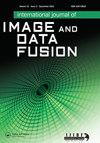低成本GPS/INS在ECEF帧下运动对准模型中的性能评估
IF 1.8
Q3 REMOTE SENSING
International Journal of Image and Data Fusion
Pub Date : 2020-09-02
DOI:10.1080/19479832.2020.1813815
引用次数: 1
摘要
摘要低成本的GPS/INS集成系统是导航与定位的理想结合。然而,低成本惯性导航系统的灵敏度不足以在导航前在静力学基础上进行初始对准。考虑到这个问题,本文提出了一个不依赖于小失准角假设的任意失准角误差传播模型和两个简化版本。这些模型是在ECEF帧方法中提出的,适用于在GPS辅助下实现运动对准。提出了基于四元数、罗德里格斯参数和修正罗德里格斯参数的三种误差模型。设计了三个实验来验证这些误差模型的准确性和计算效率。实验结果表明,小偏转角模型适用于小偏转角,具有较高的计算效率,但精度没有提高。对于任意错位角度的初始对准,大错位角度是最佳的误差模型。本文章由计算机程序翻译,如有差异,请以英文原文为准。
Performance evaluation of low-cost GPS/INS in-motion alignment model under ECEF frame
ABSTRACT Low-cost GPS/INS integration system is the ideal combination of navigation and positioning. However, the sensitivity of low-cost INS is not good enough for the initial alignment in statics base before navigation. Considering this problem, this paper presents an arbitrary misalignment angle error propagation model which does not rely on small misalignment angles assumption and two simplified versions. These models are presented in the ECEF frame approach and are suitable to implement the in-motion alignment with GPS aided. Another three error models based on quaternion, Rodrigues parameters and modified Rodrigues parameters were also proposed. Three experiments were designed to verify the accuracy and computational efficiency of these error models. The experiments’ results showed that the small misalignment angle model was applicable to the small misalignment angle for higher computational efficiency but without improvement of accuracy. And the large misalignment angle is the best error model for the initial alignment of the arbitrary misalignment angle.
求助全文
通过发布文献求助,成功后即可免费获取论文全文。
去求助
来源期刊

International Journal of Image and Data Fusion
REMOTE SENSING-
CiteScore
5.00
自引率
0.00%
发文量
10
期刊介绍:
International Journal of Image and Data Fusion provides a single source of information for all aspects of image and data fusion methodologies, developments, techniques and applications. Image and data fusion techniques are important for combining the many sources of satellite, airborne and ground based imaging systems, and integrating these with other related data sets for enhanced information extraction and decision making. Image and data fusion aims at the integration of multi-sensor, multi-temporal, multi-resolution and multi-platform image data, together with geospatial data, GIS, in-situ, and other statistical data sets for improved information extraction, as well as to increase the reliability of the information. This leads to more accurate information that provides for robust operational performance, i.e. increased confidence, reduced ambiguity and improved classification enabling evidence based management. The journal welcomes original research papers, review papers, shorter letters, technical articles, book reviews and conference reports in all areas of image and data fusion including, but not limited to, the following aspects and topics: • Automatic registration/geometric aspects of fusing images with different spatial, spectral, temporal resolutions; phase information; or acquired in different modes • Pixel, feature and decision level fusion algorithms and methodologies • Data Assimilation: fusing data with models • Multi-source classification and information extraction • Integration of satellite, airborne and terrestrial sensor systems • Fusing temporal data sets for change detection studies (e.g. for Land Cover/Land Use Change studies) • Image and data mining from multi-platform, multi-source, multi-scale, multi-temporal data sets (e.g. geometric information, topological information, statistical information, etc.).
 求助内容:
求助内容: 应助结果提醒方式:
应助结果提醒方式:


